Sony TC-KB820S User Manual

3-861-966-13(1)
Stereo
Cassette Deck
Operating Instructions |
|
EN |
|||
Mode d‘emploi |
|
|
|||
F |
|||||
Manual de instrucciones |
|
|
|||
ES |
|||||
Manual de Instruções |
|
|
|||
P |
|||||
TC-KB820S
1998 by Sony Corporation

WARNING
To prevent fire or shock hazard, do not expose the unit to rain or moisture.
To prevent fire, do not cover the ventilation of the apparatus with news papers, table-cloths, curtains, etc. And don’t place lighted candles on the apparatus.
To prevent fire or shock hazard, do not place objects filled with liquids, such as vases, on the apparatus.
To avoid electrical shock, do not open the cabinet.
Refer servicing to qualified personnel only.
Welcome!
Thank you for purchasing the Sony Stereo Cassette Deck. Before operating the unit, please read this manual thoroughly and retain it for future reference.
About This Manual
The instructions in this manual are for model TC-KB820S.
Conventions
•Instructions in this manual describe the controls on the deck.
•The following icon is used in this manual:
Indicates useful information or z tips that make a task easier.
2EN
TABLE OF CONTENTS |
|
||
|
|
|
|
Getting Started |
|
||
Unpacking 4 |
|
||
Hooking Up the System 4 |
|
||
|
|
|
|
Playing a Tape 5 |
|
||
Recording on a Tape 6 |
|
||
|
|
|
|
Advanced Playback Operations |
|
||
Locating a Track (Multi-AMS/Auto Play/Memory Play) 8 |
|
||
|
|
|
|
Advanced Recording Operations |
|
||
Adjusting Bias and Recording Level Calibration Automatically 9 |
|
||
Inserting a Blank Space During Recording (Record Muting) 10 |
|
||
EN |
|||
|
|
||
|
|
|
|
Additional Information |
|
||
Precautions 10 |
|
||
Notes on Cassette Tapes 11 |
|
||
Cleaning 11 |
|
||
Troubleshooting 12 |
|
||
Specifications 13 |
|
||
Glossary 14 |
|
||
|
|
|
|
Index 15 |
|
||
3EN
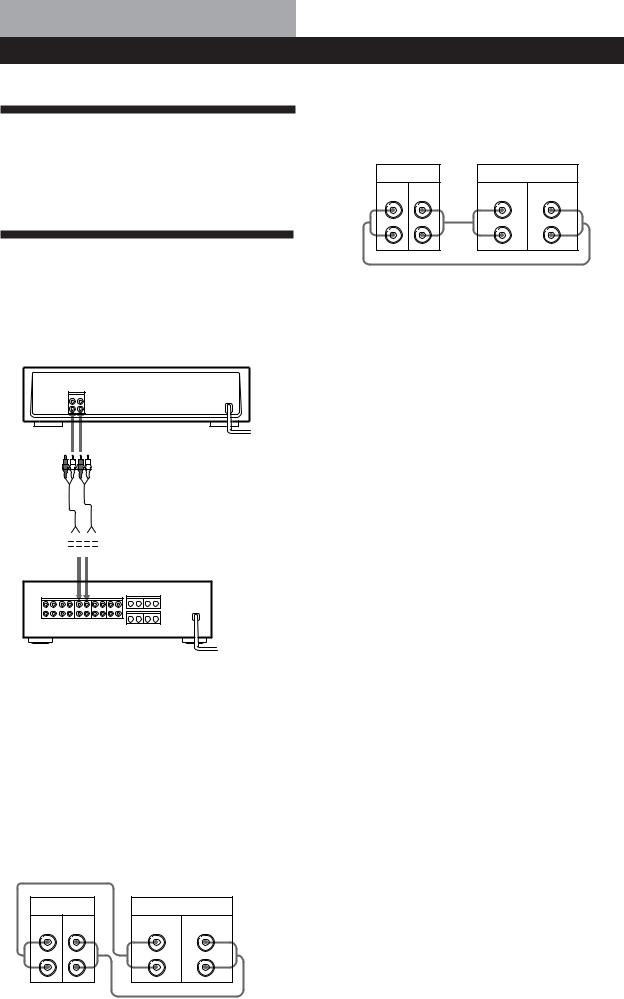
Getting Started
Unpacking
Check that you have received the following supplied item:
• Audio connecting cords (2)
Hooking Up the System
This section describes how to hook up the tape deck to an amplifier. Be sure to turn off the power of each component before making the connections.
TC-KB820S
to LINE IN |
to LINE OUT |
/ |
|
to an AC |
|||
|
|
||
|
|
(socket) outlet |
to REC OUT 


 to TAPE IN
to TAPE IN
Amplifier
/
to a
wall outlet (mains)
Hookups
When connecting an audio connecting cord, be sure to match the color-coded cord to the appropriate jacks on the components: Red (right) to Red and White (left) to White. Be sure to make connections firmly to avoid hum and noise.
Connect the tape deck to the amplifier as shown below.
Tape deck |
|
Amplifier |
Ç |
|
|
LINE |
|
TAPE |
IN OUT |
REC OUT IN |
|
L |
L |
L |
|
||
R |
R |
R |
|
|
|
ç
ç :Signal flow
To connect your tape deck to another tape deck
Connect both tape decks as shown below.
Tape deck |
Another tape deck |
||
LINE |
|
|
LINE |
IN OUT |
|
IN |
OUT |
L |
ç L |
|
L |
|
|
||
R |
R |
|
R |
|
|
|
|
|
Ç |
|
|
ç :Signal flow |
|
|
|
Connecting the AC power cord
Connect the AC power cord to an AC outlet.
Where do I go next?
Now you’re ready to use your tape deck.
For basic operations, go to pages 5 to 7; for advanced operations, go to the sections starting from page 8.
4EN
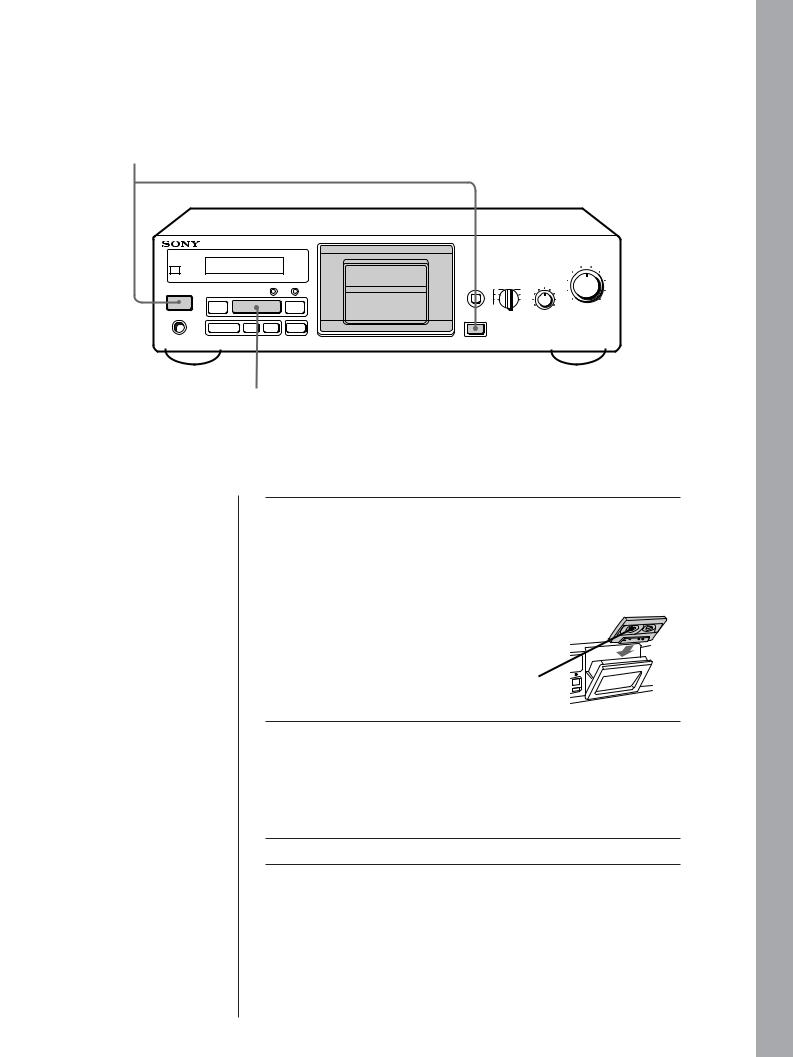
|
|
|
|
Basic Operations |
Basic Operations |
Playing a Tape
2
REC LEVEL
5
4 6
|
|
|
|
|
|
|
3 |
|
|
|
AUTO CAL |
DOLBY NR |
BALANCE |
2 |
|
|
|
|
|
OFF |
B |
|
|
|
COUNTER |
RESET |
MEMORY |
B |
|
|
|
|
|
|
|
C |
C |
|
1 |
U |
|
|
|
S |
S |
|
|
AMS |
· |
AMS |
MPX |
|
|
|
|
|
º |
‚ |
L |
R |
|
||
|
|
|
|
FILTER |
|
|
|
PHONES
|
PAUSE |
REC MUTE |
REC |
EJECT |
π |
∏ |
R |
® |
§ |
3
•See page 4 for hookup information.
zTo play a tape recorded with the Dolby NR* system
Turn DOLBY NR to the same Dolby system that the tape was recorded in—B, C, or S . Please note that the B, C, and S settings on both sides are identical during playback since the MPX filter operates only during recording.
zYou can connect the headphones to PHONES.
*Dolby noise reduction manufactured under license from Dolby Laboratories Licensing Corporation.
“DOLBY” and the double-D symbol aare trademarks of Dolby Laboratories Licensing Corporation.
1 |
Turn on the amplifier and select the tape deck position. |
2 |
Press POWER, and then press §. |
Insert a cassette and close the cassette holder. |
The tape type (I, II, or IV) appears in the display.
With the side you want to play facing you
3 Press ·.
The deck starts playing.
Adjust the volume on the amplifier.
Do not press POWER or § while the tape deck is operating.
If you do so, the tape may be damaged.
To |
Press |
|
|
Stop playing |
p |
|
|
Pause |
P PAUSE. Press the button again to |
|
resume play. |
|
|
Fast-forward or rewind |
) or 0 when the deck is stopped |
|
|
Take out the cassette |
§ after stopping playing |
|
|
Operations Basic
5EN
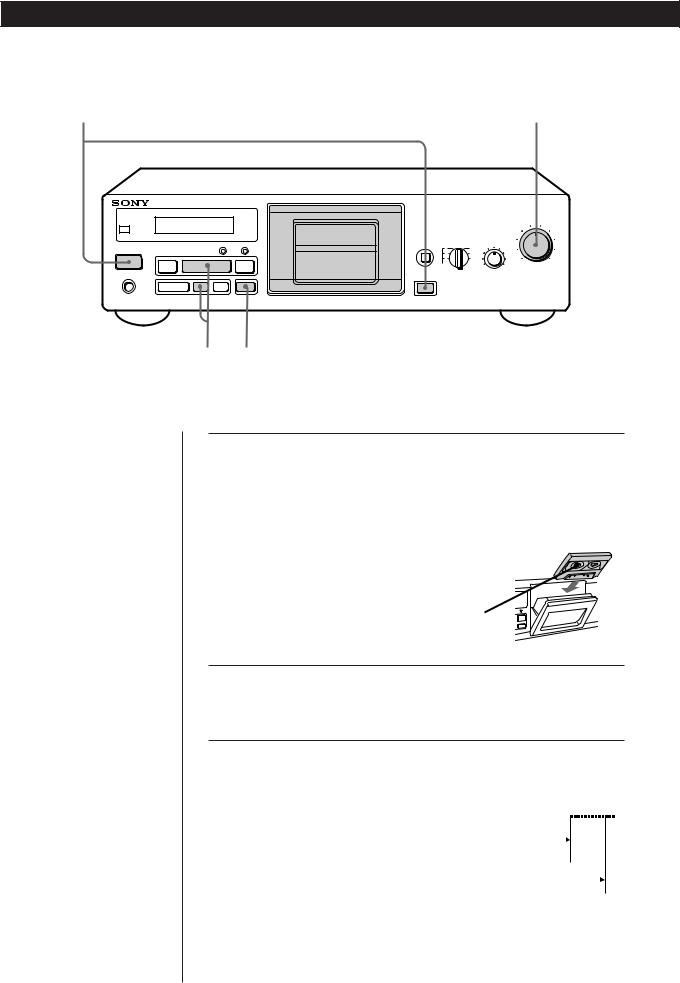
 Basic Operations
Basic Operations
Recording on a Tape
2 |
4 |
REC LEVEL
5
4 6
|
|
|
|
|
|
|
3 |
|
|
|
AUTO CAL |
DOLBY NR |
BALANCE |
2 |
|
|
|
|
|
OFF |
B |
|
|
|
COUNTER |
RESET |
MEMORY |
B |
|
|
|
|
C |
C |
|
|
|||
|
|
|
|
|
1 |
||
U |
|
|
|
S |
S |
|
|
AMS |
· |
AMS |
MPX |
|
|
|
|
|
º |
‚ |
L |
R |
|
||
|
|
|
|
FILTER |
|
|
|
PHONES
|
PAUSE |
REC MUTE |
REC |
EJECT |
π |
∏ |
R |
® |
§ |
•See page 4 for hookup information.
zTo protect recordings against accidental erasure
Break out the record-protect tab(s) (see page 11).
Note
The treble or bass sound may be recorded at a high level depending on the music you are recording. In these cases, the recorded sound may be distorted even at the “recommended level” or lower, so be sure to adjust the recording level accordingly.
53
1Turn on the amplifier and play the program source you want to record.
2Press POWER, and then press §.
Insert a cassette and close the cassette holder.
The tape type (I, II, or IV) appears in the display.
|
With the side you want to record |
|
facing you |
3 |
Press r REC. |
Do not press POWER or § while the tape deck is operating. |
If you do so, the tape may be damaged.
4 Turn REC LEVEL to adjust the recording level.
The recording level should |
|
|
|
|
|
|
|
|
|
not exceed the |
L |
∞ |
–30 –20 –10 |
|
|
–4 a 0 +2 +4 +6 +8 |
|
||
|
dB – |
|
|
|
|
|
|||
recommended level for the |
R |
|
|
|
|
|
|
|
|
|
|
|
|
|
|
|
|
||
|
|
|
|
|
|
|
|
|
|
indicated tape type. |
For type I or |
|
|
|
|
|
|||
|
|
|
|
|
|
||||
After doing the all |
type II tape |
|
|
|
|
|
|||
|
adjustments, stop playing |
For type IV tape |
|
|
|
the program source. |
|
|
|
|
|
|
|
|
|
|
|
|
|
|
5 Press P PAUSE or ·. |
|
|
|
|
Recording starts. |
|
|
|
6EN

Basic Operations
zThe Dolby HX PRO* system automatically works during recording
*HX Pro headroom extension originaled by Bang & Olufsen and manufactured under license from Dolby Laboratories Licensing Corporation.
“DOLBY, “ the double-D symbol aand “HX PRO” are trademarks of Dolby Laboratories Licensing Corporation.
For details on DOLBY HX PRO, see “Glossary” on page 14.
6 Start playing the program source.
To |
Press |
|
|
Stop recording |
p |
|
|
Pause |
P PAUSE. Press the button again to |
|
resume recording. |
|
|
Take out the cassette |
§ after stopping recording |
|
|
REC LEVEL
5
4 6
|
|
|
|
|
|
|
3 |
|
|
|
AUTO CAL |
DOLBY NR |
BALANCE |
2 |
|
|
|
|
|
OFF |
|
|
|
|
COUNTER |
RESET |
MEMORY |
B |
B |
|
|
|
|
|
|
C |
C |
|
1 |
U |
|
|
|
S |
S |
|
|
AMS |
· |
AMS |
MPX |
|
|
|
|
|
º |
‚ |
L |
R |
|
||
|
|
|
|
FILTER |
|
||
PHONES
|
PAUSE |
REC MUTE |
REC |
EJECT |
π |
∏ |
R |
® |
§ |
DOLBY NR |
BALANCE |
To adjust the recording balance
Turn BALANCE so that the L (left channel) and R (right channel) peak level meters in the display are at the levels you want.
To record with the Dolby NR system
Turn DOLBY NR clockwise to the position you want — B, C, or S before you start recording.
If you cannot get satisfying results when recording FM broadcasts with Dolby NR system
Turn DOLBY NR counterclockwise to the position you want (B, C, or S with MPX FILTER) before you start recording. The filter turns on to make the Dolby NR system work more effectively. (For details on the MPX filter, see “Glossary” on page 14.)
Operations Basic
7EN
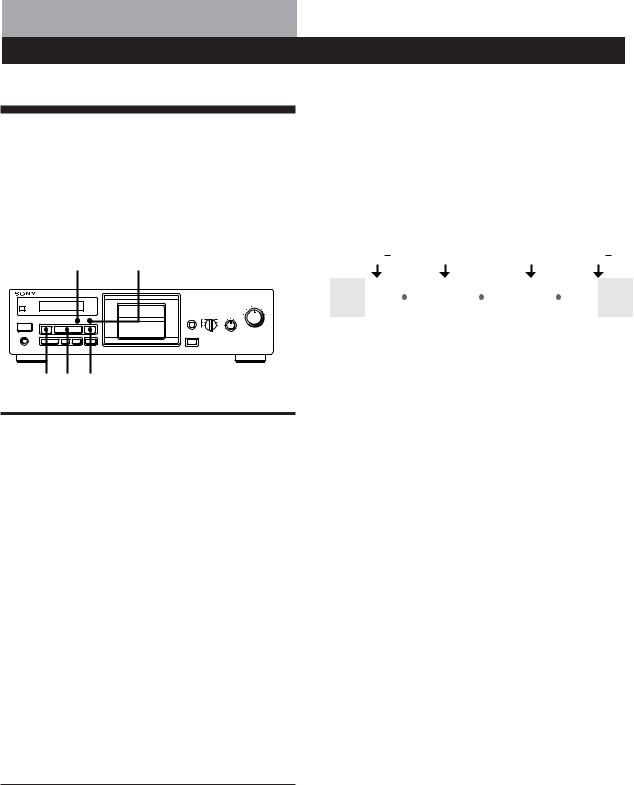
Advanced Playback Operations
Locating a Track (Multi-AMS/
Auto Play/Memory Play)
You can locate the following/previous tracks (MultiAMS: Automatic Music Sensor) or the beginning of a tape quickly. You can even locate a specific point anywhere on a tape.
RESET MEMORY
M 00 00 |
4 |
5 6 |
|
|
REC LEVEL |
|
3 |
|
|
|
|
|
|
|
AUTO CAL |
DOLBY NR |
BALANCE |
2 |
|
|
|
|
|
|
|
|
OFF |
|
|
|
|
|
COUNTER |
RESET |
MEMORY |
|
|
B |
B |
|
|
|
|
|
|
|
|
|
C |
C |
|
1 |
U |
|
|
|
|
|
|
S |
S |
|
|
AMS |
· |
|
AMS |
|
MPX |
|
|
|
||
|
º |
|
‚ |
|
L |
R |
|
|||
|
|
|
|
|
|
|
FILTER |
|
||
PHONES |
|
PAUSE |
REC MUTE |
|
REC |
EJECT |
|
|
|
|
|
π |
∏ |
R |
|
® |
§ |
|
|
|
|
0 · )
To locate |
Press |
|
|
the beginning of the next |
) as many times as you |
or succeeding tracks |
want while playing. |
(Multi-AMS*) |
For example, to locate 2 tracks |
|
ahead, press twice. |
|
|
the beginning of the |
0 once while playing |
current track (Multi-AMS*) |
|
|
|
the beginning of the |
0 as many times as you |
preceding tracks |
want while playing. |
(Multi-AMS*) |
For example, to locate 2 tracks |
|
behind, press three times. |
|
|
the beginning of a tape |
MEMORY repeatedly until |
(Auto Play) |
“M” disappears in the |
|
display. Then press 0 |
|
while holding down ·. |
|
|
a particular point on a tape (Memory Play)
MEMORY repeatedly until “M” appears in the display. Find the point you want, and press RESET to reset the tape counter and to memorize the point.
To locate the memorized point, press 0 while holding down ·. (Press 0 only to stop at “00 00.”)
*You can use the Multi-AMS to locate up to the 30th track after or before the current track.
What happens during Multi-AMS operation
When Multi-AMS is operating, “PLAY” appears. And each time the deck detects a blank space, the indicated number decreases by one. After locating the beginning of the specified track, the counter indication appears again and the deck starts playing the track.
 : Beginning of track
: Beginning of track
0 [ ] 0 [
] 0 [  ] ) [
] ) [  ] ) [
] ) [ ]
]
|
|
|
|
|
|
|
|
|
|
|
|
|
|
|
|
|
|
|
|
|
|
|
|
|
|
|
|
|
|
|
|
|
|
|
|
|
|
Previous |
|
Current |
|
Next |
|
|
|||
|
|
track |
|
track |
|
track |
|
|
|||
Notes
•The Multi-AMS function may not work correctly if:
—the blank space between tracks is less than 4 seconds long.
—the signal strength of the left and right channels are very different.
—there is a passage of low frequencies or very low volume within a track.
•Since the counter is not a digital clock, it will differ from the actual elapsed playback or recording time.
8EN
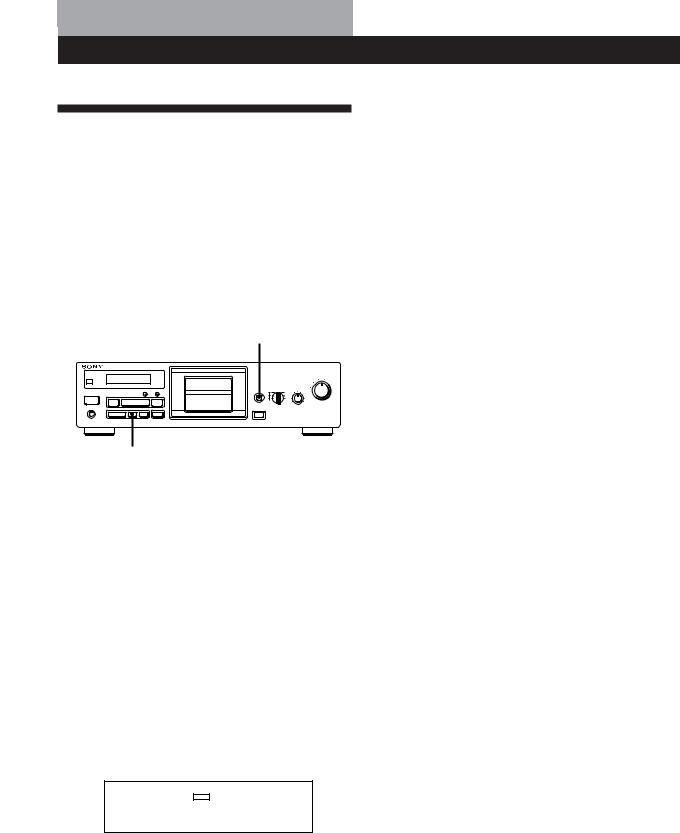
Advanced Recording Operations
Adjusting Bias and Recording
Level Calibration
Automatically
Since there are many different types of cassettes on the market, your tape deck automatically sets the appropriate equalization characteristics and bias current for each tape type (ATS: Automatic Tape Selection). However, you can get better recording results by doing the automatic bias current and the recording level calibration.
|
|
|
|
|
AUTO CAL |
|
|
|
|
|
|
|
|
|
|
|
|
|
|
|
REC LEVEL |
|
|
|
|
|
|
|
|
|
4 |
5 |
|
|
|
|
|
|
|
|
|
6 |
|
|
|
|
|
|
|
|
|
|
3 |
|
|
|
|
|
|
AUTO CAL |
DOLBY NR |
BALANCE |
2 |
|
|
|
|
|
|
|
|
OFF |
|
|
|
|
|
|
COUNTER |
RESET MEMORY |
|
|
B |
B |
|
|
|
|
|
|
|
|
|
C |
C |
|
1 |
|
|
|
|
|
|
|
S |
S |
|
|
|
U |
AMS |
· |
AMS |
|
MPX |
|
|
|
|
|
|
º |
‚ |
|
L |
R |
|
|
|||
|
|
|
|
|
|
FILTER |
|
|
||
PHONES |
|
PAUSE |
REC MUTE |
REC |
EJECT |
|
|
|
|
|
|
π |
∏ |
R |
® |
§ |
|
|
|
|
|
PPAUSE
1Insert the cassette you want to record on.
Make sure the record-protect tabs on the cassette have not been removed.
2Press AUTO CAL until “CAL” appears in the display.
Note
If the record-protect tab for that size has been removed (see page 11), “AUTO CAL” in the display flashes three times and automatic calibration cannot be performed.
3Press P PAUSE to start the automatic calibration procedure.
The automatic calibration procedure starts (i.e., recording test tones, rewinding, and playing back).
During the calibration, the counter changes from 9 to 0.
AUTO |
CA L9 |
CAL REC |
When the automatic calibration procedure ends, the tape rewinds to the original position, the counter returns to normal and the tape deck stops.
4 Start the actual recording (see page 6).
To cancel the automatic calibration function
Press p.
If “AUTO CAL” flashes continuously
The automatic calibration procedure has been interrupted by:
—The end of the tape. Turn the cassette over or rewind the tape to a new position that allows recording of the test tone.
—Damaged tape or dirty heads. Change the cassette or clean and demagnetize the heads (see page 11).
Updating the calibration setting
As long as the tape deck stays on, calibration data are saved and called up each time you insert a cassette of the same type (I, II or IV). “AUTO CAL” appears in the display when you insert a cassette to indicate that calibration data for that tape type exists. However, we recommend that you repeat the automatic calibraion procedure each time you insert a new cassette since cassettes of the same type also vary in their characteristics. Before recalibrating, be sure to clear the existing calibration data by pressing AUTO CAL until “AUTO CAL” disappears from the display. Then start from Step 2 of the automatic calibration procedure.
9EN
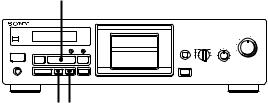
|
|
|
|
|
|
|
|
Advanced Recording Operations |
|
Additional Information |
|
|
|
|
|
|
|
|
|
|
|
|
|
Inserting a Blank Space During
Recording (Record Muting)
You can insert a blank space of 4 seconds between each track. The blank spaces between tracks let you locate the track easily with the Multi-AMS function (see page 8). Also, use this function to eliminate only unwanted portions on the tape.
·
|
|
|
|
|
|
|
|
|
|
|
REC LEVEL |
|
|
|
|
|
|
|
|
|
|
4 |
5 |
|
|
|
|
|
|
|
|
|
|
6 |
|
|
|
|
|
|
|
|
|
|
|
3 |
|
|
|
|
|
|
|
AUTO CAL |
DOLBY NR |
BALANCE |
2 |
|
|
|
|
|
|
|
|
|
OFF |
|
|
|
|
|
|
COUNTER |
RESET |
MEMORY |
|
|
B |
B |
|
|
|
|
|
|
|
|
|
|
C |
C |
|
1 |
|
|
|
|
|
|
|
|
S |
S |
|
|
|
U |
AMS |
· |
|
AMS |
|
MPX |
|
|
|
|
|
|
º |
|
‚ |
|
L |
R |
|
|
|||
|
|
|
|
|
|
|
FILTER |
|
|
||
PHONES |
|
PAUSE |
REC MUTE |
|
REC |
EJECT |
|
|
|
|
|
|
|
|
|
|
|
|
|
||||
|
π |
∏ |
R |
|
® |
§ |
|
|
|
|
|
P PAUSE R REC MUTE
1Start recording.
2Press R REC MUTE once when you want to insert a blank space.
“REC” in the display starts flashing and the tape moves on without recording any signals.
After 4 seconds, “P” lights up and the tape deck is now ready to resume recording.
3Press P PAUSE or · to resume recording.
zTo insert a blank space longer than 4 seconds
Hold down R REC MUTE as long as you want. After 4 seconds, “REC” in the display flashes faster.
When you release the R REC MUTE , “P” lights up and the tape deck is ready to resume recording.
Press P PAUSE or · to resume recording.
zTo insert a blank space of less than 4 seconds
After pressing R REC MUTE, press P PAUSE at any time. The deck changes to recording pause. To resume recording, press r REC instead of P PAUSE.
Precautions
On safety
•Do not disassemble the cabinet — this may result in an electrical shock. Refer servicing to qualified personnel only.
•Should any solid object or liquid fall into the cabinet, unplug the tape deck and have it checked by qualified personnel before operating it any further.
On power sources
•Before operating the tape deck, check that the operating voltage of the tape deck is identical with your local power supply. The operating voltage is indicated on the nameplate at the rear of the tape deck.
•If you are not going to use the tape deck for a long time, be sure to disconnect the tape deck from the wall outlet. To disconnect the AC power cord (mains lead), grasp the plug itself; never pull the cord.
•AC power cord must be changed only at the qualified service shop.
•The unit is not disconnected from the AC power source (mains) as long as it is connected to the wall outlet, even if the unit itself has been turned off.
On operation
•Because of a safety mechanism, the function buttons will not operate if the cassette holder is not completely closed, if there is no cassette in the cassette holder, or if a cassette has been incorrectly inserted into the cassette holder.
•Be sure to stop the tape before turning off the tape deck. Otherwise, the tape may be damaged.
On placement
•Place the tape deck in a location with adequate ventilation to prevent heat build-up in the tape deck.
•Do not place the tape deck:
—on a soft surface such as a rug that might block the ventilation holes on the bottom.
—in a location near heat sources.
—in a place subject to direct sunlight.
—in an inclined position.
—in a place subject to excessive dust or mechanical shock.
On cleaning the tape deck
Clean the cabinet, panel and controls with a soft cloth slightly moistened with a mild detergent solution. Do not use any type of abrasive pad, scouring powder or solvent such as alcohol or benzine.
If you have any questions or problems concerning your tape deck, please consult your nearest Sony dealer.
10EN
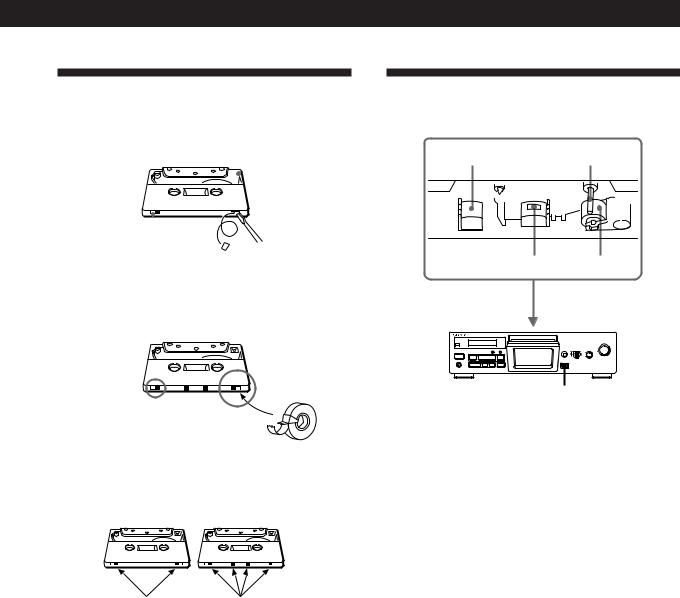
Additional Information
Notes on Cassette Tapes
To protect the recording
Break off the record-protect tab for side A or B.

 Side A
Side A
|
|
|
|
|
Tab for side A |
|
|
|
|
|
|
Tab for side B |
|
||||
To record on a tape having a broken tab
Cover the record-protect tab hole for side A or B with adhesive tape.
When you are using a type II or type IV tape, be careful not to cover the detector slots that the deck uses to determine the tape type.
Type II |
Type IV |
Detector slots |
Detector slots |
On tapes longer than 90 minutes
We do not recommend the use of tapes longer than 90 minutes except for a long continuous recording or
playback. They are very thin and tend to be stretched easily.
On handling cassettes
•To prevent the heads and tape path from getting dirty, avoid touching the tape surface of a cassette.
•Place cassettes away from equipment with magnets, such as speakers and amplifiers; it may cause tape distortion or erase the recordings.
•Do not expose cassettes to direct sunlight, extremely cold temperature or moisture.
Cleaning
Inside of the cassette holder
Erasing head |
Capstan |
Playing/Recording head Pinch roller
COUNTER
º |
· |
‚ |
|
π |
∏ R |
® |
§ |
§
Cleaning the heads and tape path
Clean the heads and tape path of the tape deck after every 10 hours of operation to guard against:
•a decrease in sound level
•excessive wow or flutter
•sound dropout
•incomplete erasure
To ensure better recording, we recommend that you clean the heads and tape path before every recording.
1Press § to open the cassette holder.
2With the tape deck turned off, wipe the heads, the pinch roller, and the capstan with a cotton swab slightly moistened with alcohol or a commercially available cleaning fluid for tape decks.
Do not insert a cassette until the cleaned areas are completely dry.
Demagnetizing the heads
After 20 to 30 hours of use, or when you notice a hissing sound or loss of high frequencies, demagnetize the heads with a commercially available demagnetizer for tape decks. Please refer to the instructions of the demagnetizer.
11EN

Additional Information
Troubleshooting
If you’ve experienced any of the following difficulties while using the tape deck, use this troubleshooting guide to help you remedy the problem. Should any problem persist, consult your nearest Sony dealer.
The function buttons do not work.
/The tape deck has just been turned on and does not operate for about 3 seconds. Wait until “P” stops flashing.
/Check that the cassette is inserted correctly and the cassette holder is closed completely.
The tape stops before the tape has been fully rewound.
/The tape is slack. Take up the tape slack.
/If “M” is shown in the display, press MEMORY repeatedly until the indication disappears.
/The cassette shell is bent. Use another cassette.
The tape deck does not play or record.
/The tape has reeled to the end.
/The tape is slack. Take up the tape slack.
/The record-protect tab has been removed from the cassette. Cover the slot with tape (page 11).
/Clean the heads and tape path and demagnetize the heads (page 11).
/Check that the tape deck is properly connected (page 4).
/Make sure the amplifier is correctly set.
There is excessive wow, flutter, or a sound dropout.
/The capstans and pinch rollers are dirty. Clean them (see page 11).
There is a decrease in sound level or a sound dropout./ The tape does not erase completely./Noise increases.
/The heads and tape path are dirty. Clean them (see page 11).
/The heads are magnetized. Demagnetize them (see page 11).
There is hum or noise.
/The tape deck is placed near a TV or VCR. Place the tape deck away from the TV or VCR.
/The tape deck is placed on or under the amplifier. Place the tape deck away from the amplifier.
There is an unbalanced tone.
/Check that the DOLBY NR control is set to the position where the tape was recorded.
/The tape deck is placed near a TV or VCR. Place the tape deck away from the TV or VCR.
The Multi-AMS function does not work properly.
/One of the tracks contains a long pause, a passage of low frequencies or very low volume, or a gradual increase or decreace in volume.
/The space before a track is less than 4 seconds long. Insert a blank space of 4 seconds using R REC MUTE button.
/The signal strength of the left and right channels are very different.
/There is noise in the space before a track.
/You pressed ) button immediately before the next track, or 0 button immediately after the beginning of the current track.
12EN

Additional Information
Specifications
System
Recording system
4-track 2-channel stereo
Fast winding time (approx.)
90 sec. (with Sony C-60 cassette)
Bias
AC bias
Heads
Erasing head × 1 (F&F head)
Playing/Recording head × 1 (SD head)
Motors
Capstan motor × 1 (DC servo motor)
Reel motor × 1 (DC motor)
Signal-to-noise ratio (at peak level, weighted, and with Dolby NR off)
Type I tape, Sony Type I (NORMAL): 55 dB Type II tape, Sony Type II (HIGH): 57 dB Type IV tape, Sony Type IV (METAL): 58 dB
S/N ratio improvement (approximate values)
With Dolby B NR on: 5 dB at 1 kHz, 10 dB at 5 kHz With Dolby C NR on: 15 dB at 500 Hz, 20 dB at 1 kHz With Dolby S NR on: 10 dB at 100 Hz, 24 dB at 1 kHz
Harmonic distortion
0.4% (with Type I tape, Sony Type I (NORMAL):
160n Wb/m 315 Hz, 3rd H.D.)
1.8% (with Type IV tape, Sony Type IV (METAL):
250n Wb/m 315 Hz, 3rd H.D.)
Frequency response (Dolby NR off)
Type I tape, Sony Type I (NORMAL):
30 - 16,000 Hz (±3 dB, IEC)
20 - 17,000 Hz (±6 dB) Type II tape, Sony Type II (HIGH):
30 - 17,000 Hz (±3 dB, IEC)
20 - 18,000 Hz (±6 dB) Type IV tape, Sony Type IV (METAL):
30 - 19,000 Hz (±3 dB, IEC)
30 - 13,000 Hz (±3 dB, –4dB recording)
20 - 20,000 Hz (±6 dB)
Wow and flutter
±0.13% W. Peak (IEC)
0.07% W. RMS (NAB)
±0.18% W. Peak (DIN)
Inputs
Line inputs (phono jacks)
Sensitivity: 0.16 V
Input impedance: 47 kilohms
Outputs
Line outputs (phono jacks)
Rated output level: 0.5 V at a load impedance of 47 kilohms
Load impedance: Over 10 kilohms
Headphones (stereo phone jack)
Output level: 0.25 mW at a load impedance of 32 ohms
General
Power requirements
Where purchased |
Power requirements |
|
|
U.K and |
220 - 230 V AC, 50/60 Hz |
Continental Europe |
|
|
|
Australia |
240 V AC, 50/60 Hz |
|
|
Power consumption |
|
20 W |
|
Dimensions (approx.) (w/h/d)
430 × 123 × 305 mm (17 × 4 7/8 × 12 1/8 inches) incl. projecting parts and controls
Mass (approx.)
4.6 kg (10 lbs 3 oz)
Supplied accessories
Audio connecting cords (2)
Optional accessory
Remote commander RM-J710
For more information on the availability of the remote commander, contact your nearest Sony dealer.
Design and specifications are subject to change without notice.
13EN
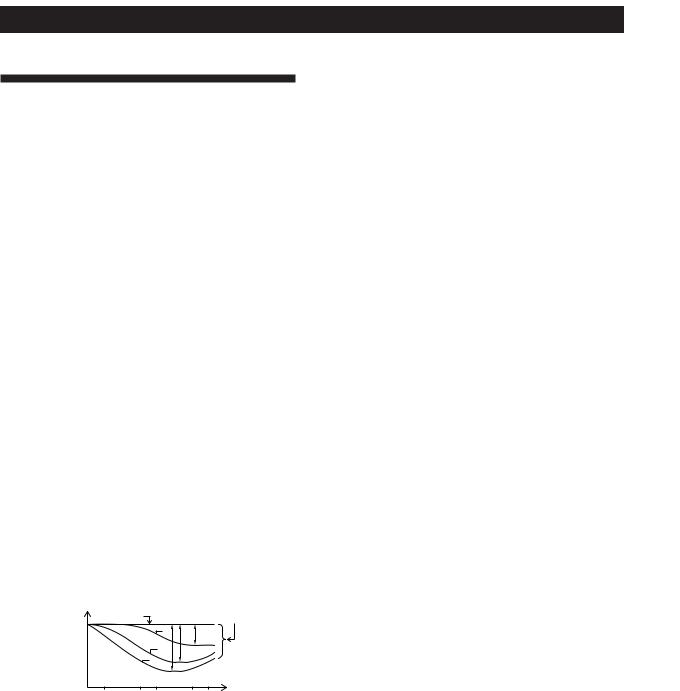
Additional Information
Glossary
ATS
Automatic Tape Selection. The tape deck automatically sets the appropriate equalization characteristics and bias current according to the tape type inserted in the deck.
Automatic calibration
The automatic adjustment of the bias current and recording level for the inserted tape.
This adjustment works together with the deck’s ATS (Automatic Tape Selection, see above) to get the best possible recording results on any tape.
Dolby HX PRO system
Distortion and noise reduction system. The Dolby HX PRO system reduces distortion and noise in high-frequency response while recording. A tape recorded with this system brings the same high-quality sound even when you play the tape on the other tape decks.
Dolby NR (noise reduction) system
Noise reduction system for eliminating hissing noise. The Dolby NR system boosts the low-level signals in high frequency during recording and restores them during playback.
There are 4 types in the Dolby NR system: A, B, C and S. A-type is for professional use (not available on this tape deck), and B, C and S-types are for consumer use. S-type has the maximum noise reduction capability, followed by C and B.
Dolby |
|
noise reduction |
dB NR off |
|
|
Output |
|
B |
|
|
|
level |
C |
|
|
S |
|
100 |
500 1k |
5k 10k Hz |
MPX filter
Multiplex filter. A filter for eliminating the 19-kHz stereo carrier and the 38-kHz sub-carrier signals that may impair the Dolby NR system. Usually the tuner has an MPX filter. If you cannot get a satisfying result when recording FM broadcasts with Dolby NR system, your tuner does not have a filter or the filter is not working. In this case, turn the DOLBY NR switch countercolckwise to the position you want — B, C, or S with MPX FILTER.
Multi-AMS
Multi-Automatic Music Sensor is a function that locates the beginning of up to 30 tracks before or after the current track by detecting a blank space (of over 4 seconds) between tracks.
Tape counter
A four-digit readout for monitoring elapsed playing or recording time. Useful for editing tapes. Press RESET to zero the counter (00 00).
Test tones
10-kHz and 400-Hz signals produced by the tape deck when you do the automatic calibration.
14EN

Index
Index
A
Adjusting
bias and recording level calibration automatically. See Automatic calibration recording balance 7 recording level 6
ATS 9, 14 Auto play 8
Automatic calibration 9 Automatic Music Sensor. See Multi-AMS
Automatic Tape Selector. See ATS
B
Balance 7
C
Cassette. See Tape Cleaning
cabinet 11
heads and tape path 11 Connecting. See Hookups Counter. See Tape counter
D, E, F
Demagnetizing the heads 11 Dolby HX PRO system 7, 14 Dolby NR system 5, 7, 14
G
Glossary 14
H
Heads cleaning 11
demagnetizing 11 Hooking up the system 4 Hookups 4
I, J, K
Insert
blank space 10 cassette 5, 6
L
Locating
beginning of the tape 8 particular point 8 tracks 8
M
Memory play 8
MPX filter. See Multiplex filter Multi-AMS 8, 14
Multiplex filter 7, 14
N, O
Noise reduction 7, 14 Notes on cassette tapes. See Tape notes
P, Q
Playing
a tape 5 auto play 8
memory play 8 Precautions 10
R
Record muting 10 Recording
on a tape 6
S
Searching. See Locating
Specifications 13
T
Tape
counter 8, 14 notes 11
path cleaning 11 protect the recording 11 type 5, 6, 11
Test tones 9, 14 Troubleshooting 12
U, V, W, X, Y, Z
Unpacking 4
Names of Controls
Buttons
AUTO CAL 9
MEMORY 8 RESET 8 0/) AMS 8 0 (rewind) 5, 8
· (play) 5, 6, 8, 10 ) (fast-forward) 5, 8 § (eject) 5 - 7
p (stop) 5, 7
P PAUSE 5 - 7, 10
R REC MUTE (record muting) 10
r REC (recording) 6, 10
Switches
DOLBY NR (noise reduction) 5, 7
POWER 5, 6
Controls
BALANCE 7
REC (recording) LEVEL 6
Jack
PHONES 5
Others
Cassette holder 5, 6
15EN

AVERTISSEMENT
Afin d’éviter tout risque d’incendie ou d’électrocution, ne pas exposer cet appareil à la pluie ou à l’humidité.
Pour ne pas risquer un incendie, ne couvrez pas les orifices d’aération de l’appareil avec des journaux, nappes, rideaux, etc. Et ne placez pas de bougies allumées sur l’appareil.
Pour éviter tout incendie ou électrocution, ne pas placer d’objet rempli de liquide, tel que vase, sur la chaîne.
Afin d’écarter tout risque d’électrocution, garder le coffret fermé. Ne confier l’entretien de l’appareil qu’à un personnel qualifié.
Bienvenue!
Merci pour l’achat de cette platine à cassette stéréo Sony. Avant de la mettre en service, veuillez lire attentivement ce mode d’emploi et le conserver pour toute référence future.
A propos de ce manuel
Les instructions de ce mode d’emploi concernent le modèle TC-KB820S.
Conventions
•Les instructions de ce mode d’emploi décrivent les commandes de la platine.
•Le symbole ci-dessus est utilisé dans ce mode d’emploi:
Indique des conseils et des
zsuggestions qui facilitent une manipulation.
2F

TABLE DES MATIÈRES
Préparatifs
Déballage 4
Raccordement de la platine 4
Lecture d’une cassette 5
Enregistrement sur une cassette 6
Fonctions élaborées pour la lecture
Localisation d’une plage (Multi-AMS/Lecture automatique/Lecture mémorisée) 8
Fonctions élaborées pour l’enregistrement
Calibrage automatique du courant de polarisation et du niveau d’enregistrement 9 Insertion d’un espace blanc pendant l’enregistrement (Silencieux d’enregistrement) 10
Informations compléntaires |
F |
|
Précautions 10 |
|
|
Remarques sur les cassettes 11 |
|
|
Nettoyage 11 |
|
|
En cas de panne 12 |
|
|
Spécifications 13 |
|
|
Glossaire 14 |
|
|
|
|
|
Index 15 |
|
|
3F
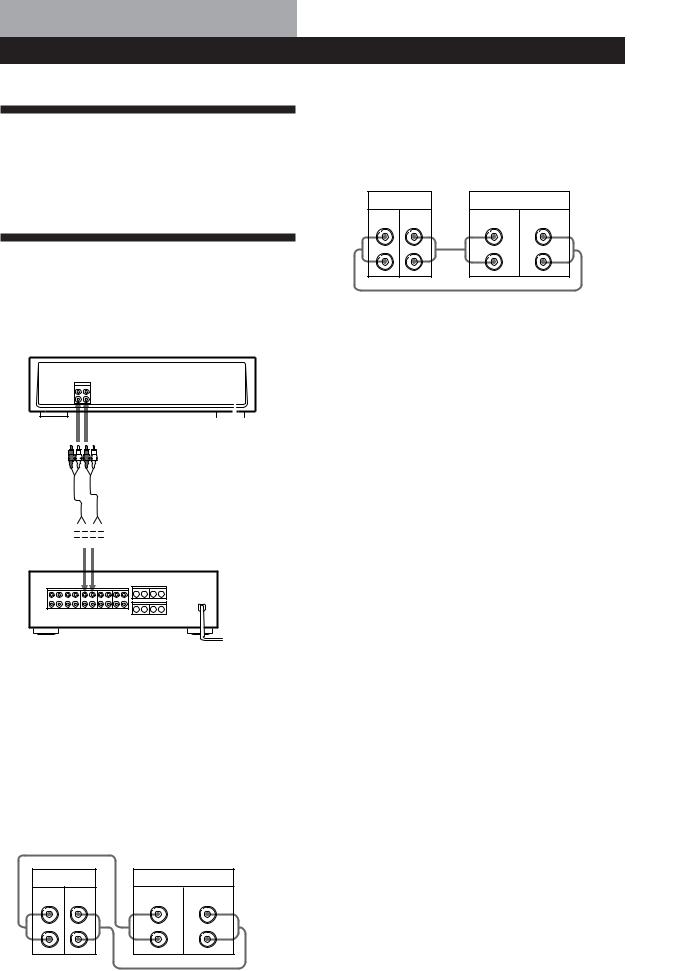
PréparatifsFonctions de base
Déballage
Vérifiez que l’élément suivant se trouve bien dans l’emballage:
• Cordons de liaison audio (2)
Raccordement de la platine
Cette partie explique comment raccorder la platine à un amplificateur. N’oubliez pas d’éteindre les deux appareils avant de les raccorder.
TC-KB820S

 /
/
vers LINE IN |
vers LINE OUT |
vers une prise |
|
|
|
|
|
secteur |
vers REC OUT 


 vers TAPE IN Amplificateur
vers TAPE IN Amplificateur
/
vers une prise murale
Raccordements
Quand vous branchez un cordon audio, vérifiez la couleur de la prise et celle de la fiche du cordon: Fiche rouge (droite) dans la prise rouge et fiche blanche (gauche) dans la prise blanche. Veillez à bien enfoncer les fiches pour éviter tout ronflement ou bruit. Raccordez la platine à l’amplificateur comme indiqué ci-dessous.
Platine à cassette |
|
Amplificateur |
Ç |
|
|
LINE |
|
TAPE |
IN OUT |
REC OUT IN |
|
L |
L |
L |
|
||
R |
R |
R |
|
|
|
ç : Flux du signal |
|
ç |
|
|
|
Pour raccorder la platine à une autre platine à cassette
Reliez les deux platines de la manière suivante.
Platine à |
Autre platine à |
|
cassette |
cassette |
|
LINE |
LINE |
|
IN OUT |
IN |
OUT |
L |
ç L |
L |
|
||
R |
R |
R |
|
|
|
Ç
ç : Flux du signal
Branchement du cordon d’alimentation secteur
Branchez le cordon sur une prise secteur.
Que faire ensuite?
Maintenant la platine à cassette est prête.
Pour les fonctions de base, voir pages 5 à 7; pour les fonctions élaborées, voir les paragraphes à partir de la page 8.
4F
